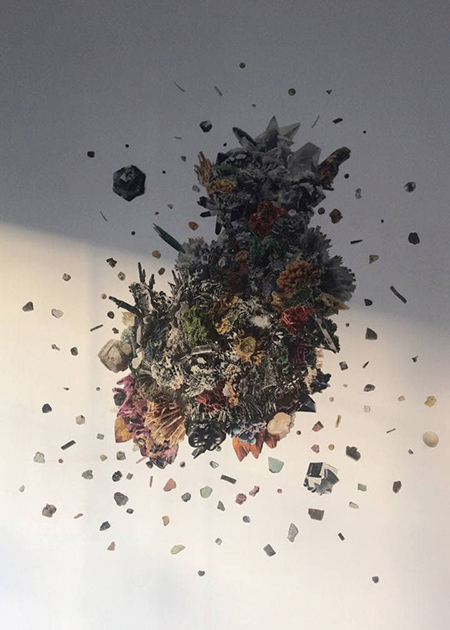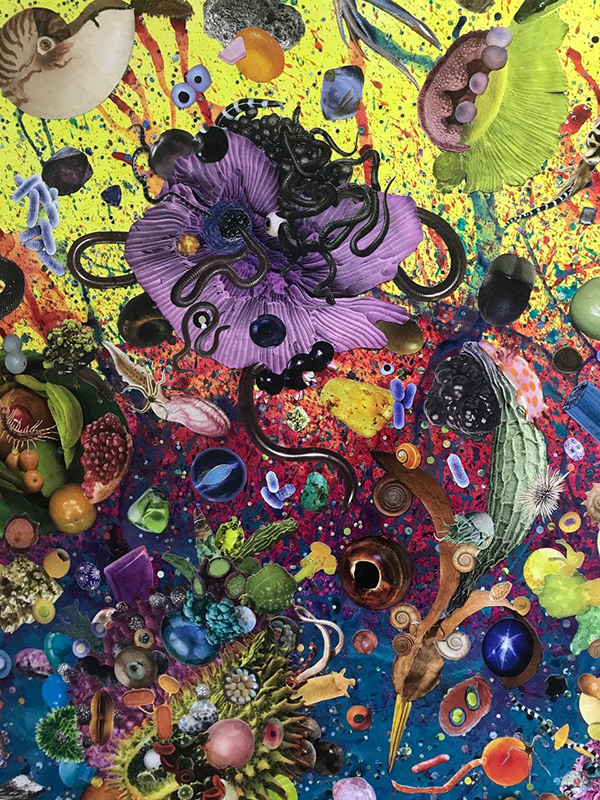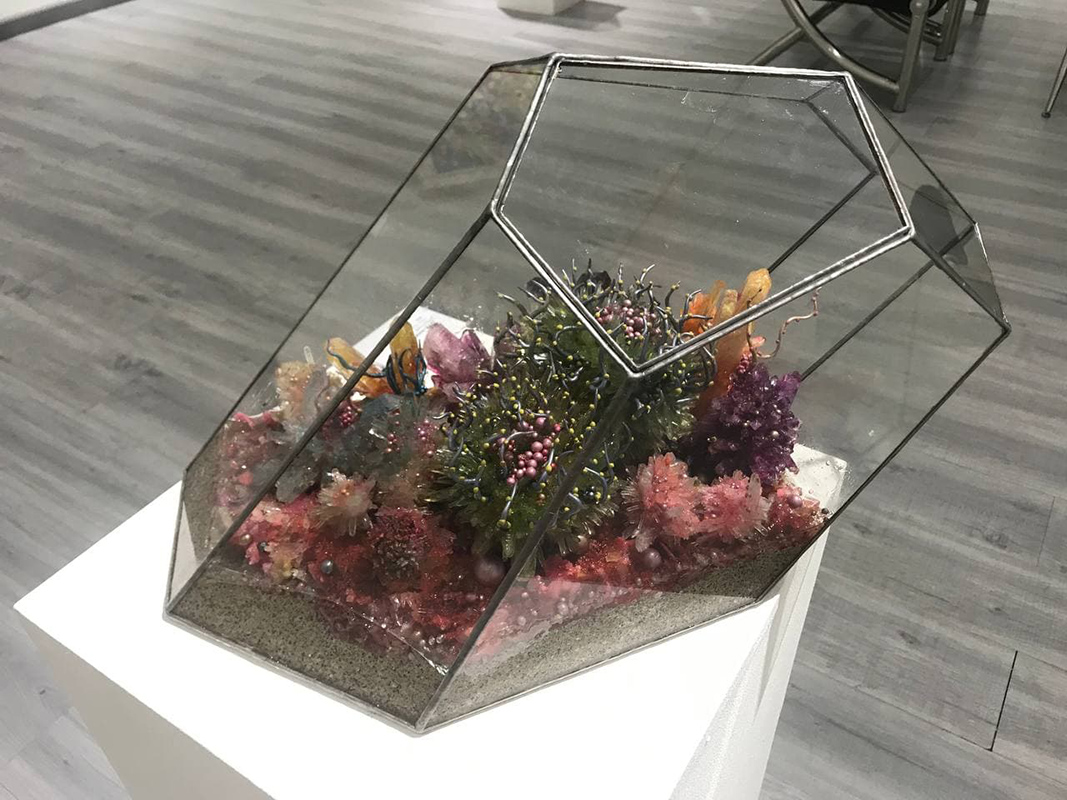Sam Feleo is an artist-mother, who once described her practice to me as “image-making”. It is a deceptively simple way to put it, and the perfect lure. Her collage works are clean-cut, absorbing, and characteristically grand in scale, measured in feet, and brimming with dizzying detail.
The same level of attention is not overlooked with her crystal works either, which were first installation works back in late 2019 and have since been repurposed into terrariums. New to her repertoire is the use of living plants for her glass terrariums, made possible through her collaboration with Anjo Joaquin. The works debuted in the ongoing group show, curated by Ambie Abaño, titled 'Day One', which has on exhibit also the works of artists Anton Villaruel, ND Harn, Yas Doctor, and Diwa Abueva.
For this interview, Sam Feleo shares an update of her practice since the first iteration of Scopic Anatomies, how it relates to process, and having one's art come in accord with the extenuating circumstances of one's life.
Let’s talk first about your collage practice. How has your relationship been with this medium?
I don’t really put restrictions to the work. When I build it, it’s never bounded to a surface. All the other elements are put together side-by-side or on top of each other. That’s why when the work develops, it also develops in an organic way, in terms of how it is shaped. It’s always an afterthought that the work gets framed for it to be hung in a room. But if I had a choice, I would always prefer for the collage work to be more organic. For it to be bounded within a frame takes away the expression of the work.
That’s why I liked the Crystal Burst, [Sonic Bloom]. I really played with that one. When I installed the work, it was the main crystal figure, then I just thought, “it needs more movement. It needs to be more dynamic.” The inclusion of the shards helped seal the idea of it as a ‘burst.’ Ever since, I’ve always been obsessed with exploding things. I’m obsessed with the scene of the exploding mansion in Zabriskie Point (1970). Have you seen that film?
I’d like to see it.
The act of explosion itself, ang ganda ganda niya eh, visually. The burst, the explosion — these have always been fascinations of mine. Even the idea and image of a Sputnik, when I would develop the crystal forms, I saw them as atomic-like, and I mean in the sense of an atomic bomb.
But it’s interesting how the terrariums you did in collaboration with Anjo Joaquin revolved around slow processes, wouldn’t you say?
I’ve always been interested in plants, in science in general. Even when I was working with crystals, I always wanted to create a self-sustaining environment for my terrariums. And I had the sphere enclosure in my workspace for so long — it’s been a long time since I got to make crystals. I lost my outdoor space in the garage, as we just live here, and I don’t want to mess with chemicals here indoors with a toddler. So, I researched on terrariums with actual plants, and then I found Anjo Joaquin. He’s a friend of my sister, and he’s really an expert. Most of the plants we used for the terrariums came from his backyard. And his backyard is bigger than the actual house.
I really had so much fun. It wasn’t so restricted in building them: Chronosphere took a day to make, Terraspire another. You don’t have to do a lot with the plants because they’re already beautiful. You don’t need to over-design or layout, not like my usual works, which I need to work on for weeks. The flow of the process was very natural, it was like a de-stress.
I was very happy. I also learned the technical aspects, too. The trick there is achieving a balance in the contained space: layering the stone and the soil for it to have a water filter — striking that balance. I learned so much from Anjo.
And the whole process was trial-and-error. When we finished doing the work, I left the works with him for over a month, and throughout some plants would die. For the spire, also, we worked with carnivorous plants, and these plants in general could outgrow the structures themselves. So, in a way, the process became a process of care: about caring, about pruning, about nurturing. The works, in a way, demand that of you And I think that’s very important, especially now.
Plantitos and plantitas would relate.
I guess it gives us that kind of comfort we long for, lalo na ngayon. Marami na masyadong deaths. But this, this is something we can nurture and grow. It demands something from you. You would need to water it, expose it to the sun.
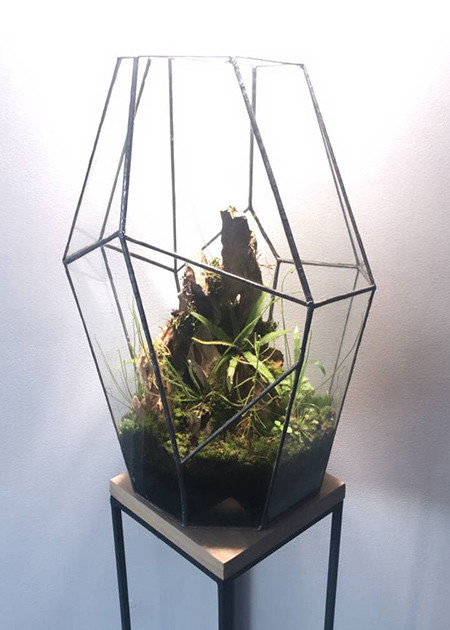
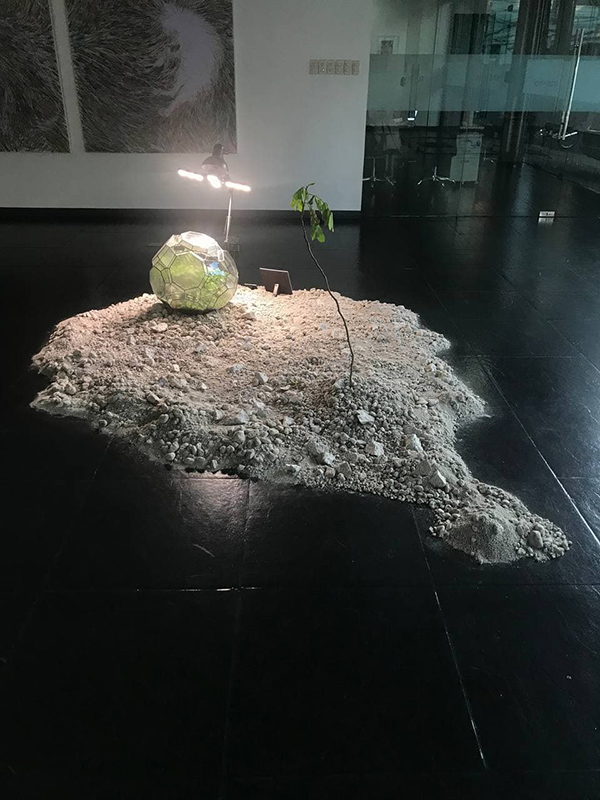
I like how the image of Chronosphere becomes so much richer from what you said, especially about that part of how the plants would eventually break through the sphere and propagate the barren land around it.
Yes, the sphere looks very alien. Especially with the extreme contrast between the sphere and the rocky, dry landscape surrounding it, the textures. Tapos the light pa, even the shape of the lamp looks like a UFO. Pinili din namin ‘yon. It all worked out in the end.
As for the spire, I really liked the idea of using carnivorous plants. These plants are very sensitive; they require a lot of care. For one, you can only give them distilled water. Did you notice the beads on their leaves? That’s the sticky stuff they use to trap insects, but it requires so much of their energy to produce those, and they depend on that so much. So, if you touched them or disrupted them in some way, they could actually die.
With the carnivores, it was trial-and-error, too, even for an expert like Anjo. A lot died from that terrarium. We even had Venus Flytraps for that work, but they didn’t survive. It took a lot of adjustments on our end.
Overall, I’m really glad to have had this experience. We plan to build some more terrariums, me and Anjo. I still have about ten enclosures with me here. Yeah. I don’t want to stress too much over artmaking anymore. I want to be more… loose? With the work? Halata naman eh no? how OC I can be with my collages? It can get very analytical.
Very laborious, also.
It is. Now, when I think about the big works, like Creations of Nature and Man-made Progeny, I’m thinking of cutting up those panels into smaller frames. One real problem is I can’t sell them. They’re so big. There are no takers — a lot are interested but, you know, who would put an eleven-foot work in their home? [laughs]
I’m not sure they make homes that big anymore!
One thing I dread is that those works are returned to me. They’re so big, they create tension in my home. As I said, this space is also shared, so it’s a real problem. I’m going to have to think of ways of cutting up the work, dispense it in some way — I don’t know.
Mm. I’m not sure how to say it, but I actually love how that’s happening to you? A year ago, you were — you wanted to create this huge piece, as if it were your opus. Now you’re working with more natural elements than chemical ones… like you want the art to be integrated more with your life, and not the other way around. Does that make sense?
Yes, yes. A friend told me once: “Art is life, life is art. It’s one and the same.” Art can’t and shouldn’t dictate your life. It must adjust with your own circumstances. And to me, yes, I need to work with what I have now. One goal is to use up the materials I have now. I’m a bit of a packrat, you know. I tend to collect. A part of that goal is to explore unconventional ways to use these different materials. Move on to the next phase.
I look forward to the group shows I’m joining next year. I have one coming up curated by Annie Pacaña with other mother artists that I look up to, like Catalina Africa, sila Tanya [Villanueva], and I really get a lot of insights from these artists. In that we are like sisters being faced with challenges but at the same time maintaining faith in our personal visions, and the discipline to continue working toward that vision. Their works are not just about a certain subject matter; it’s also about materiality: how they have to adapt to their own circumstances, how they use their experiences and translate it to art.
Among the things we have discussed is that becoming a mother is it is like a metamorphosis, it permanently changes the self… what happens to the artistic self in the process of becoming a mother? How does that manifest itself in an artist’s work? For a lot of us, we remain torn between the deep pull of work and the equally deep pull of family. And yet, from the depths of division, new work continues to emerge. Personally, I have learned that ambition should not be my primary fuel. These days I make art because without it, I dont have any constructive outlet… and when that happens it’s a disaster cos my energy emerges frequently as rage.
I’ve actually started collecting dust around the house. It’s been about six months since I started collecting. I recently got a nice vacuum cleaner. Cordless. And I’m always vacuuming, and there’s so much dust, so much hair — and these are all by-products of ourselves. I’m at that stage where I’m just gathering it, still. I’m thinking of using it for a sculpture but, really, I’m just letting it be. I tend to work with a lot of things at the same time. And, maybe like you, I tend to work better under pressure, when the show is looming.
Yeah. It’s around that point where all inhibitions fly out the window.
And the thinking, the thinking never stops. And for me, apart from being more loose with how I work with my materials and subject matter, I want it to be more broad. I want to explore other avenues, in relation still to nature, since now I’m dealing with… mortality? Death will always be around us but, with the people in my life — I think I’ll be forced to think about that in the coming months. And I would like to go into that aspect of my work more. Since I’m working with natural elements, even my crystals decay overtime. Even my works at CCP, the outdoor installation.
The Primordial Soup!
Yes, I hope to revisit those when my space opens up or when my schedule gets better. Next year… I hope Nate can start with school next year. That way I can get back to working more next year, hopefully.
Sam Feleo is an artist-mother with works on view at Altro Mondo. At the second floor is the physical run of her solo 'Scopic Anatomies', in partnership with Cartellino for the archival prints; at the ground floor upon entry are her works in collaboration with Anjo Joaquin, for the group show 'Day One'. Both shows continue until November 28.

